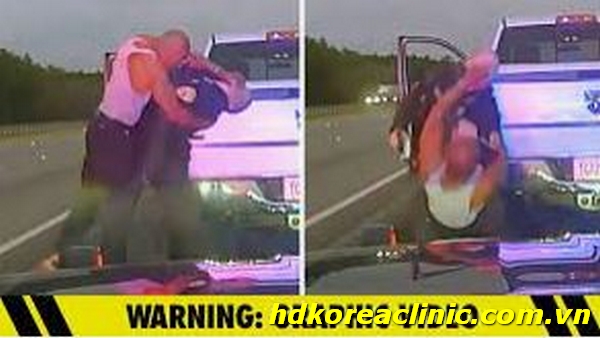Leonard Cure Body Cam: Tragic fate

The “Leonard Cure Body Cam“ case revolves around a heartbreaking incident that occurred during a routine traffic stop. Leonard Cure, a man who has been wrongly imprisoned for more than a decade, finds himself at the center of a tragic encounter with law enforcement. The incident attracted widespread attention after the dashcam footage was released, shedding light on the events that occurred on that fateful day. This introduction hdkoreaclinic.com.vn provides an overview of the case, setting the stage for a deeper exploration of the circumstances and meanings surrounding the “Leonard Cure Body Cam” incident.
I: Details of the Traffic Stop and Fatal Encounter
The core of the “Leonard Cure Body Cam” case unfolds in the intricate details of a routine traffic stop turned fatal encounter. It all commenced with a seemingly ordinary traffic stop, documented by dashcam footage. Leonard Cure’s vehicle was pulled over by a deputy, suspecting reckless driving. However, what should have transpired as a standard interaction took an unforeseen and tragic turn.

As the deputy approached Cure’s vehicle, Cure initially resisted a command to place his hands on the back of the truck. The atmosphere grew increasingly tense as Cure defiantly declared, “I ain’t doing (expletive),” challenging the authority of the deputy.
In an attempt to enforce compliance, the deputy resorted to the threat of a stun gun. This pivotal moment marked a critical turning point in the encounter. Cure reluctantly complied, placing his hands on the truck. Nevertheless, he continued to question the rationale behind the traffic stop, sparking a verbal exchange with the officer.
When Cure failed to adhere to commands to place his hands behind his back, the deputy resorted to discharging his stun gun. The body camera footage captured the intense reaction as Cure spun around, attempting to break free from the electrical current coursing through his body.
In a tragic culmination of events, Cure seized the deputy by the roadside, amidst the backdrop of speeding highway traffic. Both men became embroiled in a physical struggle, with their arms interlocked around each other’s necks. Cure managed to gain control, gripping the deputy’s lower face and neck, forcing his head backward.
Throughout this high-stakes altercation, Cure can be heard uttering, “Yeah, bitch!” A single gunshot abruptly punctuated the scene, and Cure collapsed to the ground. The deputy, now holding his handgun, urgently issued commands and called for immediate assistance.
This detailed narrative, complemented by pivotal dialogue excerpts, offers a comprehensive portrayal of the critical moments leading to the tragic outcome in the “Leonard Cure Body Cam” case.
II: Social Reaction and Psychological Impact
The “Leonard Cure Body Cam” case has elicited a profound response from society, transcending the boundaries of the incident itself. This section explores the multifaceted social reaction and the psychological impact it has had on various parties involved:
Public Outcry and Calls for Accountability:
The incident’s release through body-worn cameras has ignited a public outcry for justice and accountability. People from diverse backgrounds have united in their demand for answers and transparency. The stark video evidence has prompted calls for a thorough and impartial investigation into the circumstances surrounding Leonard Cure’s tragic death. Communities at large have expressed their concern, emphasizing the need to address issues of police conduct and use of force.
Civil Rights Attorney Ben Crump’s Advocacy:
Leonard Cure’s family is being represented by the prominent civil rights attorney Ben Crump, known for his involvement in high-profile cases related to racial injustice and police brutality. Crump’s presence in this case draws parallels with his representation of other families, including those of Ahmaud Arbery, Breonna Taylor, George Floyd, and Trayvon Martin. His advocacy underscores the broader context of civil rights and social justice, amplifying the significance of the “Leonard Cure Body Cam” case.
Broader Societal Concerns:
The incident serves as a catalyst for more profound discussions about justice and public safety within society. It has sparked dialogue about the role of law enforcement, the imperative of transparency, and the need for comprehensive reform. The public discourse surrounding this case reflects deep-seated concerns about the intersection of race, policing, and the quest for justice in contemporary society. It highlights the collective aspiration for a criminal justice system that ensures fairness, accountability, and the protection of civil rights.

In essence, the “Leonard Cure Body Cam” case transcends being an isolated incident and serves as a lens through which broader societal concerns and demands for change are brought to the forefront. It underscores the critical need for accountability within law enforcement and calls for a reevaluation of systemic issues contributing to such tragic encounters.
III: Leonard Cure’s Wrongful Conviction and Release
Leonard Cure’s tumultuous encounter with the criminal justice system began with his conviction for the 2003 armed robbery of a drug store in Dania Beach, Florida. This conviction, which came after a second jury trial due to a deadlock in the first, resulted in Cure receiving a life sentence. His previous convictions for robbery and related offenses exacerbated his legal troubles.
However, in a pivotal turn of events, the Broward State Attorney’s Office established a Conviction Review Unit in 2020, dedicated to reevaluating cases like Cure’s. This specialized unit uncovered troubling aspects of Cure’s conviction, including the existence of robust alibis that had been previously disregarded. Moreover, a critical lack of credible evidence linking him to the crime scene became apparent.

An independent review panel, comprised of five local lawyers, echoed these concerns, further solidifying the case for reexamination. The breakthrough came with the discovery of evidence that definitively placed Leonard Cure miles away from the drug store at the time of the robbery. Key among this evidence was a crucial receipt that contradicted his alleged involvement. Additionally, it was revealed that a victim had identified Cure through a photo array in an identification procedure that was deemed unreliable and suggestive.
In a momentous decision in December 2020, a judge took the significant step of vacating Leonard Cure’s conviction and sentence. This landmark ruling not only freed Cure from wrongful imprisonment but also underscored the critical importance of continuous scrutiny and reevaluation of past convictions. The “Leonard Cure Body Cam” case serves as a poignant reminder of the enduring pursuit of justice, even when it necessitates confronting the injustices of the past.
IV: Conclusion and Significance of the “Leonard Cure Body Cam” Incident
In summary, the “Leonard Cure Body Cam” incident highlights the vital role of body-worn cameras in law enforcement transparency. It also connects to the broader civil rights and justice narrative, with the involvement of attorney Ben Crump. This incident has spurred crucial discussions about justice and public safety, emphasizing the need for systemic reform. Leonard Cure’s wrongful conviction and subsequent exoneration underscore the importance of revisiting past convictions to rectify injustices. Ultimately, this case resonates with the ongoing pursuit of a more equitable and just society, calling for reform, accountability, and the protection of civil rights.









